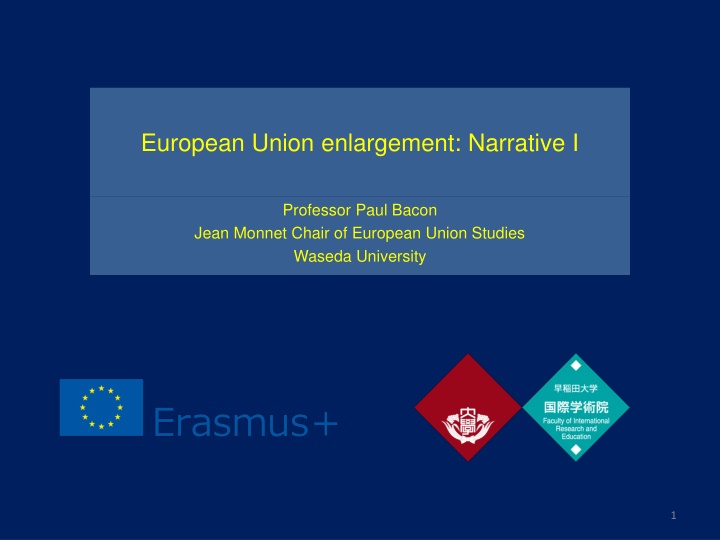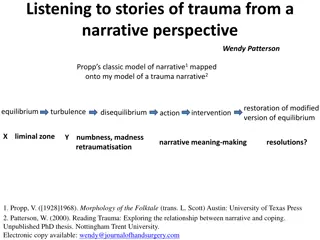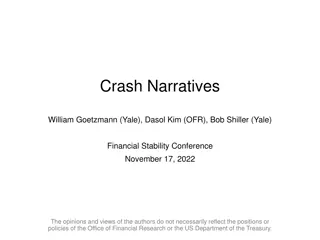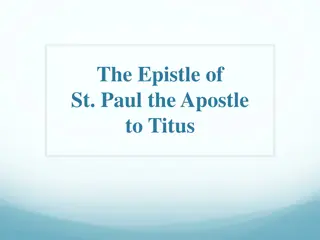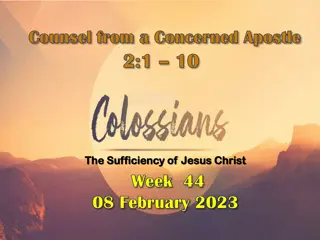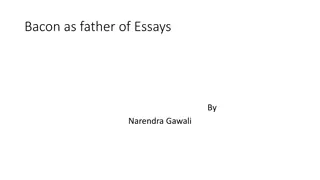EU Enlargement Narratives by Professor Paul Bacon
Professor Paul Bacon, Jean Monnet Chair of European Union Studies at Waseda University, delves into the three main narratives surrounding EU enlargement. He discusses the transformative power of Europe, conditionality in the EU's enlargement policy, and the treaty provisions guiding EU enlargement. Explore the complex dynamics of EU expansion and its impact on member states and candidates.
Download Presentation

Please find below an Image/Link to download the presentation.
The content on the website is provided AS IS for your information and personal use only. It may not be sold, licensed, or shared on other websites without obtaining consent from the author.If you encounter any issues during the download, it is possible that the publisher has removed the file from their server.
You are allowed to download the files provided on this website for personal or commercial use, subject to the condition that they are used lawfully. All files are the property of their respective owners.
The content on the website is provided AS IS for your information and personal use only. It may not be sold, licensed, or shared on other websites without obtaining consent from the author.
E N D
Presentation Transcript
European Union enlargement: Narrative I Professor Paul Bacon Jean Monnet Chair of European Union Studies Waseda University 1
EU enlargement: Three narratives In the two topic lectures on EU enlargement, I want to suggest that there have been, broadly, speaking, three main narratives about EU enlargement. In the first of these two topic lectures, I will focus on the first narrative. This first narrative tends to present EU enlargement in a somewhat positive light. This narrative closely follows the arguments in Sedelmeier and Avery, EU Expansion and Wider Europe , in Kenealy, Peterson, and Corbett, eds., 2018. The European Union: how does it work?. Oxford, Oxford University Press. Narratives two and three are covered in the second of the two topic lectures on enlargement. 2
The Transformative Power of Europe? The EU has a very strong self-image. The EU is founded on the normative (moral) principles of liberty, democracy, respect for human rights and fundamental freedoms, and the rule of law. The EU requires potential members, and encourages its partners, to respect and uphold these principles. Particularly with regard to EU enlargement, people have talked about the transformative power of the EU. Most analysts agree that the EU has successfully demonstrated this powers in its near abroad to a substantial degree. 3
Conditionality According to Karen Smith, to an impressive extent, the EU s enlargement policy has been its most successful foreign policy. Through conditionality, the EU has transformed the domestic political, economic and social systems of European states who want to join the EU. For this topic lecture I will talk in some detail about the EU s enlargement policy. To see the EU s official homepage on EU enlargement, please click here: https://ec.europa.eu/neighbourhood-enlargement/policy/steps- towards-joining_en You can find all the very latest information on EU enlargement on this site, including progress towards membership for current candidate states. 4
Treaty Provisions on EU Enlargement The Treaty on European Union, as amended by the Lisbon Treaty, states: Article 2: The Union is founded on the values of respect for human dignity, freedom, democracy, equality, the rule of law and respect for human rights, including the rights of persons belonging to minorities. Article 49: Any European state which respects the values referred to in Article 2 and is committed to promoting them may apply to become a member of the Union. 5
The 3 (4!) Copenhagen Criteria The European Council at Copenhagen (1993) stated in its conclusions: Membership of the European Union requires: 1. that the candidate country has achieved stability of institutions guaranteeing democracy, the rule of law, human rights and respect for and protection of minorities. 2. the existence of a functioning market economy as well as the capacity to cope with competitive pressure and market forces within the Union. 3. the presupposition of the candidate s ability to take on the obligations of membership including adherence to the aims of political, economic and monetary union. The European Council added: 4. The Union s capacity to absorb new members, while maintaining the momentum of European integration, is also an important consideration in the general interest of both the Union and the candidate countries. 6
The path to EU membership 1 Start: A country submits an application for membership to the European Union s Council of Ministers. 1. The Council asks the Commission for an Opinion. 2. The Commission delivers its Opinion to the Council. 3. The Council confirms the applicant country s candidate status. 4. The Council decides to open accession negotiations. These are conducted in an intergovernmental conference between the EU member-states and each applicant, individually. 7
The path to EU membership 2 5. The Commission screens the different chapters of the acquis communautaire with the applicant. 6. For each chapter in the negotiations that the EU decides to open, the applicant state presents a position; the Commission proposes a common position ; the Council approves the common position for presentation to the applicant state. 7. After agreement is reached on a chapter, the EU decides whether to close it. 8. When all chapters are closed, the EU and the applicant agree on a draft Treaty of Accession. 9. The Commission issues its Opinion on the Treaty. 8
The path to EU membership 3 10. The European Parliament gives its consent to the Treaty. 11. The member-states and the applicant state sign the Treaty. 12. The signatory states ratify the Treaty according to national procedures (which may require referenda). Finish. The Treaty of Accession comes into force, and the applicant state becomes a member-state. 9
An intergovernmental or supranational process 1? The mode of operation for enlargement is, officially, essentially intergovernmental in character. The Council adopts all decisions on enlargement by unanimity, not by QMV. No-one has ever suggested extending QMV to enlargement. Accession negotiations take place in an intergovernmental conference which is organized between the member-states and the applicant state. The outcome of this process is an Accession Treaty, which must be signed and ratified unanimously between sovereign member states. 10
An intergovernmental or supranational process 2? The role of the European Parliament is reasonably limited. It does have the right to veto any enlargement, and must approve enlargements via the consent procedure. The Parliament votes at the end of the negotiation process on a yes / no basis, but without being able to modify the text of the Treaty. During accession negotiations, Parliament is informed regularly, but has no seat at the table. The Commission s status in accession negotiations is not the same as for external trade negotiations, where it acts as a spokesperson for the Union. In accession conferences, the Council Presidency, rather than the Commission presents EU positions, even on issues where the Commission has competence. 11
An intergovernmental or supranational process 3? Officially the Commission is not the EU s negotiator for enlargement issues, although it may sometimes be mandated by the Council to seek solutions with applicants. Despite the above points, it is very important to note that the Commission plays an extremely influential role in the enlargement process. This fact demonstrates that influence can be exercised even in the absence of formal, official power. The Commission is better equipped technically than member- states to monitor the progress of applicant countries, with regard to the criteria for EU membership. 12
An intergovernmental or supranational process 4? The Commission writes detailed evaluative annual reports on each country preparing to join the EU. The assessments contained in these reports provide the benchmarks for decisions on the conduct of enlargement strategy. In matters where it has competence, the Commission has the sole right to present proposals to the Council for common positions to be taken by the EU side. The Commission is thus in a privileged position to act as an intermediary with applicant countries, and can and should make proposals that reflect the views of future members as well as existing members. 13
An intergovernmental or supranational process 5? Within the Council of Ministers, enlargement is handled in the General Affairs Council, not the Foreign Affairs Council. The EU High Representative has no role in enlargement negotiations. When foreign policy passed to the European External Action Service as a result of the Lisbon Treaty, enlargement policy remained within the Commission. This shows in a way that enlargement is not primarily about foreign policy. To briefly reiterate, although the enlargement process is officially an intergovernmental one, the Commission in fact plays a key role. For access to more information, and to the annual Commission reports for each of the countries preparing to join, please click here: http://ec.europa.eu/enlargement/countries/strategy-and-progress- report/index_en.htm 14
Member-states of the EU The EU currently has 27 member-states. These are identified below, along with their year of accession: 1952 (6 members): The Original 6 of France, Germany, Italy, Belgium, the Netherlands, Luxemburg. 1973 (9 members): + Denmark, Ireland, the UK. 1981 (10 members): + Greece. 1986 (12 members): + Portugal, Spain. 1995 (15 members): + Austria, Finland, Sweden. 2004 (25 members): + Czech Republic, Cyprus, Estonia, Hungary, Latvia, Lithuania, Malta, Poland, Slovakia, Slovenia. 2007 (27 members): + Bulgaria, Romania. 2013 (28 members): + Croatia. Note that EU membership has almost doubled in the last 10 years, from 15 members to 28 members (then went back down to 27 ). 15
Why do countries want to join the EU 1? Countries want to join the EU because they believe it to be in their political and economic interest. In the case of the UK, its application was motivated by the prospective benefits of the common market for its trade and economic growth. The UK also realized that a European system was being created that the UK could not afford to be politically excluded from. Ireland and Denmark had a tradition of agricultural exports to the UK, and to the original six members, and it was therefore natural for them to apply as well. 16
Why do countries want to join the EU 2? The applications from Greece, Portugal and Spain were made under different circumstances. These three countries had recently been governed by authoritarian regimes, and felt that membership offered both a confirmation and a guarantee of their return to democracy. It was important for all of these countries to have access to the common market and to the budget. Newer members, especially poorer ones, received considerable financial support, in the form both of agricultural subsidy and cohesion funding. However, it is was also important for these countries to feel that they were being welcomed back into the European family. 17
Why do countries want to join the EU 3? Austria, Finland and Sweden applied for membership of the EU, despite already having access to the common market through the European Economic Area. For these three countries, the benefits of the EEA were compromised by the obligation to accept rules from Brussels without having a say in deciding them. These countries also realized that the collapse of the Soviet Union and the Soviet bloc created a new political situation in Europe in which their political neutrality was less appropriate. It was feared by EU member-states that the accession of these three states, which had pursued policies of neutrality during the Cold War, would have a negative effect on the development of the EU s Common Foreign and Security Policy (CFSP). However in practice, these three have viewed the CFSP s development more favourably than some of the older members. 18
Why do countries want to join the EU 4? When the 10 countries of Central and Eastern Europe made the change from communism and Soviet domination, they turned to the EU for membership as well as for economic help. Like earlier applicants, they wanted to rejoin the European family, and to consolidate their return to democracy. They wanted access to the agricultural subsidies and cohesion funding which was on offer. But they also wanted to transition from central planning to market economies, and European economic systems and standards provided suitable goals, benchmarks and templates. Importantly, uncertain of Russia s future role, they wanted EU membership for national security and as a back-up to NATO membership, both of which they pursued at the same time. 19
The big bang, 10+2 enlargement 1 The collapse of the Soviet Union in 1989 was an extremely significant event, which heralded the end of the Cold War international system. There was a high risk of instability in Europe as a result. A series of civil wars broke out in the former Yugoslavia, and similar conflict could have broken out in other places on the continent, if events had developed differently. In contrast to the former Yugoslavia, countries from Central and Eastern Europe found a way to establish democracy, stability and prosperity. They did this by making far-reaching economic, social and political reforms. The possibility of EU membership stimulated them to pursue peaceful regime change, in which the process of Europeanization played a key role. (Europeanization is the adaptation of domestic politics to the EU s rules, norms and policies). 20
The big bang, 10+2 enlargement 2 The EU was faced with many countries who made it clear that they wanted to join in the early 1990s. The EU s first response to this demand was cautious. The EU refused to include the promise of membership in its new Europe Agreements (which covered aid, trade and political links). However, at the Copenhagen summit in 1993, the EU accepted that the countries of Central and Eastern Europe could join once they had fulfilled certain criteria for membership. The Copenhagen criteria were defined for the first time at that summit. 21
The big bang, 10+2 enlargement 3 Accession negotiations opened with 6 countries in 1998, and another 6 in 2000. The main problems in these negotiations were: free movement of labour: the EU allowed older member-states to maintain restrictions on the entry of workers from new member-states for up to 7 years; agricultural policy: the EU insisted on a period of 12 years for introducing direct payments to farmers in the new member-states; and money: the level of payments to new, much poorer members from the EU budget became a contentious issue. The conditionality of the process created a framework within which the Central and Eastern countries could make a transition to democracy and market economy, peacefully and on a durable basis. The economic consequences of enlargement were positive for both old and new member-states. 22
The big bang, 10+2 enlargement 4 However, the influx of migrants from the new member- states has caused social problems in many countries. Right-wing parties which make EU immigration a policy priority have become popular in many countries across the EU. This phenomenon has perhaps been most conspicuous in Finland, France, Sweden, and the UK. Also, bad governance (for example corruption, maladministration, weak judiciary) persists in some countries, such as Bulgaria, Hungary, Poland and Romania. As a result of this, many people argue that the accession process should have been managed in a far tougher way for some countries. 23
The big bang, 10+2 enlargement 5 Despite some problems, the 10+2 enlargement was an extremely significant episode in the history of European integration. This enlargement process shifted the EU s scale of activity and membership scope to a continental level. The formation of the European political experiment, and subsequent enlargements to it, took place within the context of a Europe which was divided between East and West. The 10+2 enlargement was historically significant in that it re-united East and West. 24
Balkan countries 1 In Southeast Europe about 20 million people remain outside the EU: Albania (3.6M), Bosnia-Herzegovina (4.5M), the Former Yugoslav Republic of Macedonia (2.1M), Kosovo (1.8M), Montenegro (0.7M), and Serbia (7.3M). These countries, known as the Western Balkans, are surrounded by the EU. They are trying to make the reforms which are necessary to join the EU, but have a difficult legacy of ethnic, social and religious conflict. For much of the 20thCentury these countries were part of Yugoslavia, but the end of the Cold War led to the disintegration of the Yugoslav Federation, leading to civil war, and the intervention of the UN and NATO. There are also basic problems with sovereign statehood. The question of Kosovo s independence is not fully resolved, as its independence from Serbia is not recognized by all EU members, and its government is still supervised by an EU Rule of Law Mission (EULEX). Bosnia is still under external tutelage, supervised by a UN High Representative who is also an EU Special Representative. 25
Balkan countries 2 The region suffers from poor governance, corruption and criminality, and also from dependence upon external actors. However reform, and EU membership, require autonomy and a functioning democracy. Each of the countries listed above are at different stages on the journey to EU membership. The Stability and Association Process (SAP) package has been a stepping-stone. All of the countries listed above have either applied for EU membership or intend to do so. The international community now sees the Western Balkans as mainly Europe s responsibility. At a summit in Thessaloniki in 2003, EU leaders recognized all countries in the Western Balkans as prospective members. The region poses an interesting and important test for the ongoing existence of the EU s transformative power. It remains to be seen whether conditionality and pre-accession instruments can be as successful in the Western Balkans as they were in Central Europe. And also whether European integration can be a basis for regional stability by encouraging good governance and reconciliation between communities. 26
Turkey and EU enlargement 1 Turkey signed an Association Agreement with the then European Community as long ago as 1964. Turkey applied for membership in 1987. However, the path to membership has been long, and remains difficult. Despite the fact that accession negotiations began in 2005, Turkey s future membership of the EU is by no means assured. Many of the reasons for previous applications to the EU also apply to Turkey. Turkey seeks to benefit from the agricultural subsidies and cohesion funding that is available to new members of the EU. Membership of the EU would fulfil Turkey s European vocation, and would signify the crowning achievement of the objectives of Ataturk s modernization and secularization project for Turkey. 27
Turkey and EU enlargement 2 Turkey s growing economy and young labour force would bring benefits to the EU s single market. Turkey s population is 78 million, expected to grow to 90 million in future. Turkey s geographic location gives it geostrategic importance in relation to the Middle East and the Black Sea region. As a member of NATO, Turkey has played a key role in European security. Historically, the US has pushed for Turkey to be rewarded for being a good NATO citizen with membership of the EU. Many argue that by admitting Turkey, the EU would send a positive signal to other countries and the world that it accepts Islam, and that forms of Islam can be compatible with liberal democracy. On the other hand, refusing Turkey would suggest that Europe was culturally prejudiced, could lead to a reversal of Turkey s reforms, and even turn it against the West. 28
Turkey and EU enlargement 3 On the other side of the ledger, there are various arguments that are often made against Turkish membership. Although Turkey is secular, and progress has been made towards meeting Copenhagen criteria relating to democracy, human rights and the rule of law, more needs to be done. Among the main problems in this regard are Turkey s treatment of its Kurdish minority, its restrictions on freedom of expression, and the political role of its military. Some argue that just as religion is not a good reason to say no to a country, it is also not a good reason to say yes . Although Turkey s population is Islamic, it is not an Arab country, and it has a legacy of difficult relations with neighbours such as Armenia. Also, with Turkey s accession, the EU s external frontiers would extend to Azerbaijan, Armenia, Iran, Iraq and Syria, so it would be in direct contact with some of the most unstable or otherwise problematic countries in the world. Some say Turkey currently serves as a useful buffer state, protecting the EU from the implications of having boundaries with these countries. 29
Turkey and EU enlargement 4 Public opinion in the EU is also fearful of an influx of Turkish migrant workers. Some people believe that Turkey is different, and that it is not part of Europe in cultural or geographic terms. Turkish membership is opposed by a number of political parties and countries within the EU. France has threatened to hold a referendum on Turkish membership if and when the time comes. Merkel has at times suggested that membership of the EU may not be the best option for Turkey, and suggested that multiculturalism is not working in Germany. Austria has objections to Turkish membership based on its difficult historical encounters with the Ottoman Empire. It is also argued that the EU s decision-making system would have difficulty coping with Turkey, which would be one of the EU s most populous states. The EU has now transitioned to the voting criteria set out in the Lisbon Treaty, and these criteria place a significant emphasis on the significance of population size. As well as the other criticisms of Turkey, if Turkey joined, it would immediately become one of the most powerful decision-making states in the EU. 30
Turkey and EU enlargement 5 The Cyprus issue is another problem for Turkey. The Turkish Republic of Northern Cyprus is not recognized by the rest of the international community, and attempts by the UN have failed to resolve the situation. Cyprus therefore joined the EU in 2004 as a divided island. Some argue that even if it does not finally become a full member of the EU, Turkey has an interest in continued modernization in line with modernization criteria. It is now an open question whether Turkey joins the EU, and there is a growing risk of crisis in the accession negotiations. Progress has been slow, and the opening of several chapters of the acquis has been blocked by France and Cyprus. Beginning in 2012 and continuing through most of 2013, formal accession talks between Turkey and the EU had reached a political and technical stalemate. It appears that little or no progress was made on any open chapters of the EU s rules and regulations known as the acquis communautaire, and no additional chapters were opened. 31
Turkey and EU enlargement 6 In May 2012, noting the accession stalemate, the EU Commission launched what was termed the positive agenda with Turkey, intended to bring fresh dynamics into EU-Turkey relations. Some have referred to the positive agenda as an institutional trick intended to circumvent Ankara s refusal to deal with certain aspects of the EU involving the Cypriot presidency which was set to begin on July 1, 2012. It is unclear what the positive agenda accomplished or what its current status is. For many Turks, EU membership seems to have lost its appeal as Turkey s economy continues to thrive and as Ankara continues to try to reposition and strengthen itself in its own neighborhood, between secular Europe and the Islamist emergence in the Middle East. Many Turks seem to feel being European or gaining membership in the Union is no longer needed in order to secure Turkey s status or to have an otherwise normal partnership with Europe. 32
Iceland, Norway and Switzerland 1 Iceland applied for EU membership in July 2009, following a banking crisis which revealed its vulnerability as a small country. It would be comparatively straightforward for Iceland to fulfil most of the acquis-related criteria. However, there are possible problems with regard to fisheries policy, and the rejection of EU membership in a referendum. In May 2013, the Icelandic government decided to put accession negotiations on hold. The Norwegian government previously negotiated and signed two Accession Treaties, but was not able to join because membership was rejected in public referenda in both cases. As a result of this, politicians in Norway are reluctant to re-visit the question of EU enlargement. 33
Iceland, Norway and Switzerland 2 Norway is a member of the EEA, and therefore has access to the common market, and participates in other EU policies. Switzerland s application for membership was suspended when its citizens voted no in a referendum on joining the EEA in 1992. Since then, Switzerland has pursued its interests through bilateral agreements with the EU. The French-speaking part of the Swiss population is in favour of membership, but this is opposed by the German-speaking population. All three of these small, wealthy countries would be accepted as candidates were they to apply again or, in the case of Iceland, to re-open accession negotiations. 34
European Neighbourhood Policy 1 After expanding to include Central and Eastern Europe, the EU inherited a new set of neighbours to the east. The EU had to re-think relations with other countries in Eastern Europe that had formerly been part of the Soviet Union. Also, new EU members such as Poland and Hungary did not want their accessions to lead to the creation of new barriers against countries with which they have cultural, social and economic links. The EU already had a Euro-Mediterranean Partnership with countries to the south. Several Eastern European countries were added to this to create an European Neighbourhood Policy (ENP) group, consisting of the following 16 countries: Morocco, Algeria, Tunisia, Libya, Egypt, Israel, Jordan, the Palestinian Authority, Lebanon, Syria; Armenia, Azerbaijan, Georgia, Moldova, Ukraine and Belarus. 35
European Neighbourhood Policy 2 The purpose of the ENP was to extend stability, prosperity and security, and create a ring of friends , by developing political links and economic integration with the EU. The main instrument is a series of Action Plans negotiated with each partner country, and supported by financial and technical assistance. Action Plans cover issues such as political dialogue, economic and social reform, trade, energy, environment, education, etc. The plans require countries to adopt European regulations and a large part of the acquis. The ENP Action Plan model is based on a similar structure to that of the EU s Accession Partnerships with future members. However, and crucially, the ENP lacks the big incentive contained in the enlargement process the possibility of future membership. The core message is to be like us rather than to be one of us . 36
European Neighbourhood Policy 3 For Eastern European countries such as Ukraine, the fact that the policy is accession-neutral has been disappointing. Even after recent events in the Ukraine, and problems with respecting the ceasefire agreement reached in Minsk 2, the EU is very careful with its language with regard to the possibility of future Ukrainian membership of the EU. Frankly, this remains unlikely. Although the ENP offers long-term benefits, it also demands reforms that are difficult and costly. The ENP also does not fully satisfy participants wishes, for example over issues such as agricultural trade, and the provision of travel visas to the EU. The ENP does however provide increased financial aid and a closer political relationship. 37
European Neighbourhood Policy 4 The ENP has sometimes been criticized as a one-size-fits-all formula for two groups of states with quite different interests and problems. Mediterranean countries may be neighbours of Europe, so the complaint goes, but Eastern European countries are neighbours in Europe. In practice, Action Plans are tailored to fit the individual needs of countries, wherever they might be geographically located. However, these criticisms have been reflected in the development of two more recent initiatives that reflect the distinctiveness of the two areas. In 2008, on the initiative of France, relations were deepened through the development of a Union for the Mediterranean . In 2009 an initiative by Poland and Sweden led to the creation of the Eastern Partnership with Armenia, Azerbaijan, Belarus, Georgia, Moldova and Ukraine. This Partnership also remains accession-neutral, but provides improved political cooperation, further economic integration, and increased financial assistance. Partnerships are intended to lead to Association Agreements, which have in the past led to accession processes in other cases. 38
European Neighbourhood Policy 5 Despite the declared aims of the ENP, the EU has had limited success in exploiting it to promote democracy either in Belarus or in the Southern neighbourhood. In the past, the EU offered to extend the ENP to Russia, but the offer was rejected, as Russia has preferred to see itself as a strategic partner of the EU. Russia remains, to say the least, highly suspicious of the motives of the EU and NATO, and of their links with Eastern Partnership countries. Russia invaded Georgia in 2008 to demonstrate its capacity to influence events in the neighbourhood through the use of force. Many commentators also argue that Russia has used force in Ukraine to a similar end, because it is determined that the EU and NATO s involvement with the East European neighbourhood does not extend to security. A fuller analysis of the Ukraine crisis is unfortunately beyond the scope of this introductory class. It is clear that parts of the Ukrainian population find the soft power of the EU highly attractive, and have been prepared to take to the streets and participate in demonstrations to show this. We should also perhaps reflect a little on the question of whether the EU s neighbourhood policy has in fact contributed to stability, prosperity and security in the region. 39
What is Europe(an)? In 1992, as it was becoming clear that the European Union would consider many new applicants for membership, the European Commission offered the following opinion: The term European has not been officially defined. It combines geographical historical cultural elements which all contribute to the European identity. The shared experience of proximity ideas values historical interaction cannot be condensed into a simple formula, and is subject to review by each succeeding generation. It is neither possible nor opportune to establish now the frontiers of the European Union, whose contours will be shaped over many years to come. This was a smart attempt by the Commission at that time to refuse to give a direct answer to this conceptually interesting, and politically highly significant question. 40
Limits to enlargement 1? The EU can not expand indefinitely. So, where might its boundaries lie? In actual fact, the Copenhagen criteria prioritize shared values rather than geography. Politically liberal countries with market economies can apply. But does this mean the likes of Canada and New Zealand can apply, for example? 41
Limits to enlargement 2? Some years ago, Timothy Garton Ash, the English public intellectual, wrote a playful and thought-provoking essay on the possibility of Canadian membership of the EU in the Guardian newspaper: http://www.theguardian.com/commentisfree/2006/jun/29/comme nt.eu Robert Cooper wrote an influential article and book in which he argued that the world is divided into modern, postmodern and premodern states. Postmodern states are political democracies with market economies, and Cooper identified EU member-states as postmodern in character. Interestingly, he also recognized Japan as a lonely postmodern state operating in East Asia. We might also add South Korea and Taiwan to the somewhat short list of postmodern countries in the Asian region. 42
Limits to enlargement 3? Clearly, it is not possible for all postmodern countries to join the EU, as they are not European, and some are very remote indeed from the EU. So membership is ruled out. But it is not difficult to imagine the possibility of non-European postmodern states developing highly robust and consequential regimes of cooperation with the EU and / or European states. An example of this would be the negotiations for an EPA / Strategic Partnership Agreement between the EU and Japan, and also the growing cooperation between NATO and Japan. Also, if the UK is not able to negotiate and EPA with Japan, or negotiates an EPA with lower regulatory standards, this would mean that Japan was more closely aligned with EU values and trade standards than the UK. The EU is providing a template for what the international relations of postmodern states might look like, and what the potentials are. This does not necessarily have to involve EU enlargement and EU membership. This is one of the other ways in which the shared values that underpin the EU and EU enlargement can continue to be diffused dynamically around the world. 43
The future of EU enlargement 1 The pace of and prospects for enlargement depend not only on the applicant countries, but also on the attitude of politicians and the public within the EU. The issue of absorption capacity has now become an element in the debate. This issue was raised in the fourth Copenhagen criterion, referring to the need to maintain the momentum of European integration. This fourth criterion explicitly links future enlargement to the development of the EU s institutions, policies and budget. Enlargement begins as a form of foreign policy for the EU. Through this policy neighbour countries of the EU, which might be unstable, conflict- prone, or potential enemies of the EU are socialized, transformed, Europeanized and ultimately, domesticated within the EU. The transformative power of enlargement is said to make these countries safe for the EU, strengthening the idea of the EU as a zone of democratic peace. 44
The future of EU enlargement 2 EU enlargement is also an existential policy. What we mean by this is that every enlargement also transforms the EU itself in some way. For example, the big bang enlargement introduced several new members of the EU who were considerably poorer than the pre- existing EU average. How might we evaluate the success of EU enlargement? We can think of two criteria. The first is whether an enlargement enhances security, stability and prosperity for both the EU and the neighbouring countries concerned. The second is whether the introduction of a new member is harmonious, and contributes to the satisfactory continuation of the EU s development. (Does a new member disrupt existing members, or the functioning of the EU s institutions and policies?). 45
The future of EU enlargement 3 What has been the result of the expansion of the EU from 15 to 27 (28) members? Some feared that the introduction of so many new members would make it more difficult for the EU to make decisions, but this does not seem to have happened. Some worried that the introduction of so many new members would lead to variable geometry . What we mean by this is a multi-speed, patchwork, more fragmented Europe. However, most of the new members, unlike some old members, have joined the Schengen system, and many of them have also joined the euro. 46
The future of EU enlargement 4 The big bang enlargement definitely made the EU-28 (27) become more complex and heterogenous. There is also a worry with regard to enlargement fatigue . Public opinion in the EU, and particularly in some of the older member- states, is more resistant to enlargement. The increased internal mobility provided for by the 2004 enlargement has been a catalyst for populism in some EU member states, with Brexit as an important example of this phenomenon. Enlargement is sometimes blamed for problems which arise from other causes such as globalization or global recession. Accessions may also in future be more likely to be put to referenda in existing member-states, with all of the uncertainty that this entails. This means that the EU will have to be very rigorous in applying its conditions to potential members, and more careful about the offers that it makes to other countries. 47
The future of EU enlargement 5 The expansion of the EU has been remarkable in its speed and impact. However, its membership more than doubled between 1995 and 2007, and EU expansion will be slower and more measured in the future. Activity will be limited to countries in the Balkans, and Turkey, whose accession is uncertain. Iceland, Norway and Switzerland could all join very quickly if they chose to do so, but this is not on the cards at the moment. The ongoing Ukraine crisis makes it unlikely that there will be any significant moves to incorporate Neighbourhood Policy or Eastern Partnership countries into the EU anytime soon. In 2014, Commission President Jean-Claude Juncker made clear his opposition to further enlargement on his watch. At the start of his Commission mandate he stated that Following the extensive enlargement of the Union in the last decade, the next five years [2014-2019] will be a period of consolidation, with no further enlargement taking place during our mandate . He was true to his word. 48
